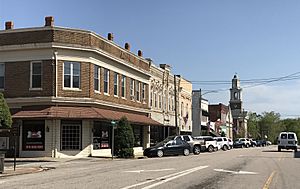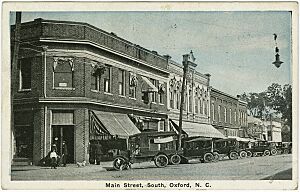Oxford, North Carolina facts for kids
Quick facts for kids
Oxford, North Carolina
|
|||
|---|---|---|---|

Main Street
|
|||
|
|||
| Motto(s):
"Historic, Walkable, Friendly"
|
|||

Location of Oxford, North Carolina
|
|||
| Country | United States | ||
| State | North Carolina | ||
| County | Granville | ||
| Founded | 1811 | ||
| Incorporated | 1816 | ||
| Named for | A plantation owned by Samuel Benton | ||
| Area | |||
| • Total | 6.24 sq mi (16.15 km2) | ||
| • Land | 6.23 sq mi (16.14 km2) | ||
| • Water | 0.00 sq mi (0.01 km2) | ||
| Elevation | 449 ft (137 m) | ||
| Population
(2020)
|
|||
| • Total | 8,628 | ||
| • Density | 1,384.47/sq mi (534.54/km2) | ||
| Time zone | UTC−5 (Eastern (EST)) | ||
| • Summer (DST) | UTC−4 (EDT) | ||
| ZIP code |
27565
|
||
| Area code(s) | 919 | ||
| FIPS code | 37-49800 | ||
| GNIS feature ID | 2404455 | ||
Oxford is a town located in Granville County, North Carolina, in the United States. In 2020, about 8,628 people lived there. Oxford is also the main town, or county seat, of Granville County.
Contents
History
Oxford's story began in 1761. A local lawmaker named Samuel Benton built a large farm, known as a plantation, and called it "Oxford." The government decided that the area around his farm would become the center of Granville County. However, Oxford officially became a town in 1816.
Early Schools and Homes
The first Masonic orphanage for children in the United States was built in Oxford. An orphanage is a home for children who have lost their parents or cannot be cared for by their families. It started as St. John's College in 1858. The college closed soon after it opened. In 1872, people in the community decided the property should be used to help children in need. In 1873, the first children moved into the Oxford Orphans Asylum. Today, it is known as the "Masonic Home for Children at Oxford."
In 1851, a school called Horner Military School was founded in Oxford. Many young men from different states came to study there. Some of these students later became important leaders in the United States government. For example, James Crawford Biggs became a top lawyer for the U.S. government. After a fire destroyed the school buildings in 1913, the school moved to Charlotte, North Carolina.
The Oxford Female College was started in 1850 by a group called North Carolina Baptists. This college was for girls and young women. It faced money problems and was later sold, becoming a private school called "Oxford Female Seminary." In 1880, F. P. Hobgood took over the school, and it became very popular. The school closed in 1925 after Hobgood passed away.
In 1883, the state government created the Central Children's Home of North Carolina in Oxford. This home also cared for children. Henry Plummer Cheatham, who used to be a U.S. congressman, became the leader of this home in the early 1900s. He led the institution for 28 years.
Modern History and Monuments
In 1970, an event in Oxford led to important racial protests. These events were written about in a book called Blood Done Sign My Name (2004) and later made into a movie in 2010.
A statue honoring Confederate soldiers was put up in Oxford in 1909. It was built by a group called the Granville Grays United Daughters of the Confederacy. The monument was placed in the town's courthouse square. It was a memorial to soldiers from Granville County who fought in the Civil War.
After the protests in Oxford in 1970, the town moved the monument from the courthouse square to a spot in front of the Richard H. Thornton Library. In June 2020, the statue was removed and is now kept in storage.
Several important places in Oxford are listed on the National Register of Historic Places. This means they are recognized for their historical value. These include the Central Orphanage, Granville County Courthouse, Joseph B. Littlejohn House, Locust Lawn, Oxford Historic District, Paschall-Daniel House, Archibald Taylor Plantation House, and Thorndale.
Geography
Interstate 85 runs along the edge of Oxford. You can get on or off I-85 at Exits 202, 204, and 206. This highway goes southwest about 29 miles to Durham and northeast about 100 miles to Petersburg, Virginia.
U.S. Route 15 goes through the middle of Oxford. It is known as Lewis Street, Hillsboro Street, and College Street. This road leads southwest about 14 miles to Creedmoor and north about 23 miles to Clarksville, Virginia. U.S. Route 158 goes around the northern side of Oxford. It leads east about 12 miles to Henderson and west about 25 miles to Roxboro.
The United States Census Bureau says that Oxford covers a total area of about 6.06 square miles (15.7 square kilometers). All of this area is land.
Oxford is divided into three voting areas, called precincts, within Granville County. These are Credle, East Oxford, and South Oxford.
Population
| Historical population | |||
|---|---|---|---|
| Census | Pop. | %± | |
| 1850 | 669 | — | |
| 1860 | 878 | 31.2% | |
| 1870 | 916 | 4.3% | |
| 1880 | 1,349 | 47.3% | |
| 1890 | 2,907 | 115.5% | |
| 1900 | 2,059 | −29.2% | |
| 1910 | 3,018 | 46.6% | |
| 1920 | 3,606 | 19.5% | |
| 1930 | 4,101 | 13.7% | |
| 1940 | 3,991 | −2.7% | |
| 1950 | 6,685 | 67.5% | |
| 1960 | 6,978 | 4.4% | |
| 1970 | 7,178 | 2.9% | |
| 1980 | 7,709 | 7.4% | |
| 1990 | 7,913 | 2.6% | |
| 2000 | 8,338 | 5.4% | |
| 2010 | 8,461 | 1.5% | |
| 2020 | 8,628 | 2.0% | |
| 2021 (est.) | 8,775 | 3.7% | |
| U.S. Decennial Census | |||
In 2020, the population of Oxford was 8,628 people. There were 3,454 households and 2,235 families living in the town.
In 2010, Oxford had 8,461 people living in 3,410 households. About 55.6% of the people were Black or African American, and 38.6% were White. Other groups included Asian, Native American, and people of two or more races. About 4.8% of the population identified as Hispanic or Latino American.
The average household size was about 2.48 people. About 23.4% of the population was under 18 years old. The median income for a household in Oxford was $32,050. This means half of the households earned more than this amount, and half earned less.
Economy
Oxford is home to several important businesses and organizations. Revlon has its largest manufacturing factory here, along with its IT department. CertainTeed has a plant that makes roofing supplies.
Other businesses in Oxford include Bailey Farms Inc., which grows and distributes chili peppers. Macra Lace Textiles and Shalag make different types of fabrics. Gate Precast Concrete makes concrete products. Ideal Zipper makes zippers, and AWNC Toyota manufactures car parts. The Masonic Home for Children and the Biofuels Center of North Carolina are also located in Oxford.
Notable people
- Tiny Broadwick, a brave parachutist pioneer
- Benjamin Chavis, a leader in the civil rights movement
- Henry Plummer Cheatham, a U.S. congressman
- Hannah Cifers, a mixed martial artist
- Franklin Wills Hancock Jr., a member of the U.S. House of Representatives
- Isaiah Hicks, a basketball player for the North Carolina Tar Heels
- Junius Horner, an Episcopal bishop
- Martha Hunt, a famous model
- Ed Meadows, an NFL defensive end and college football All-American
- Lee Meadows, a pitcher who played for the 1925 World Series champion Pittsburgh Pirates
- Richard Moore, the North Carolina State Treasurer
- Ayesha Rascoe, an American journalist for NPR
- Marshall L. Shepard, a politician and clergyman from Pennsylvania
- Thad Stem, Jr., a poet, author, and newspaper writer
- Hiram Tarkington, a United States Army officer
- Abraham Watkins Venable, a politician
- James E. Webb, a former administrator of NASA who helped guide the U.S. lunar landing efforts
Schools
- C. G. Credle Elementary School
- J.F. Webb High School
- J.F. Webb High School of Health and Life Sciences
- Joe Toler-Oak Hill Elementary School
- Mary Potter Middle School
- Northern Granville Middle School
- West Oxford Elementary School
- Oxford Preparatory School
See also
 In Spanish: Oxford (Carolina del Norte) para niños
In Spanish: Oxford (Carolina del Norte) para niños




